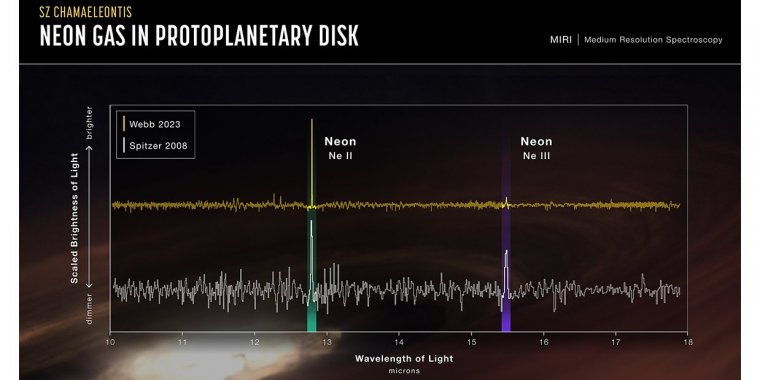| News / Space News |
Webb Follows Neon Signs Toward New Thinking on Planet Formation
Scientists are following neon signs in a search for clues to one planetary system’s future and the past of another – our own solar system. Following up on a peculiar reading by NASA’s previous infrared flagship observatory, the now-retired Spitzer Space Telescope, the agency’s James Webb Space Telescope detected distinct traces of the element neon in the dusty disk surrounding the young Sun-like star SZ Chamaelontis (SZ Cha).

Data from NASA’s James Webb and Spitzer space telescopes reveals a change in the disk surrounding SZ Cha in just 15 years. In 2008, Spitzer’s detection of significant neon III made the star an outlier among similar young protoplanetary disks, but in 2023 Webb revealed a ratio of neon II to III within typical levels. Credit: NASA, ESA, CSA, Ralf Crawford (STScI)
Differences in the neon readings between Spitzer and Webb point to a never-before-observed change in high-energy radiation that reaches the disk, which eventually causes it to evaporate, limiting the time planets have to form.
“How did we get here? It really goes back to that big question, and SZ Cha is the same type of young star, a T-Tauri star, as our Sun was 4.5 billion years ago at the dawn of the solar system,” said astronomer Catherine Espaillat of Boston University, in Massachusetts, who led both the 2008 Spitzer observations and the newly published Webb results.
“The raw materials for Earth, and eventually life, were present in the disk of material that surrounded the Sun after it formed, and so studying these other young systems is as close as we can get to going back in time to see how our own story began.”
Scientists use neon as an indicator of how much, and what type, of radiation is hitting and eroding the disk around a star. When Spitzer observed SZ Cha in 2008, it saw an outlier, with neon readings unlike any other young T-Tauri disk.
The difference was the detection of neon III, which is typically scarce in protoplanetary disks that are being pummeled by high-energy X-rays.
This meant that the high-energy radiation in the SZ Cha disk was coming from ultraviolet (UV) light instead of X-rays. Besides being the lone oddball result in a sample of 50 to 60 young stellar disks, the UV vs. X-ray difference is significant for the lifetime of the disk and its potential planets.
“Planets are essentially in a race against time to form up in the disk before it evaporates,” explained Thanawuth Thanathibodee of Boston University, another astronomer on the research team.
“In computer models of developing systems, extreme ultraviolet radiation allows for 1 million more years of planet formation than if the evaporation is predominately caused by X-rays.”
So, SZ Cha was already quite the puzzle when Espaillat’s team returned to study it with Webb, only to find a new surprise: The unusual neon III signature had all but disappeared, indicating the typical dominance of X-ray radiation.
The research team thinks that the differences in neon signatures in the SZ Cha system are the result of a variable wind that, when present, absorbs UV light and leaves X-rays to pummel the disk.
Winds are common in a system with a newly formed, energetic star, the team says, but it is possible to catch the system during a quiet, wind-free period, which is what Spitzer happened to do.
Espaillat’s team is already planning more observations of SZ Cha with Webb, as well as other telescopes, to get to the bottom of its mysteries.
“It will be important to study SZ Cha, and other young systems, in multiple wavelengths of light, like X-ray and visible light, to discover the true nature of this variability we’ve found,” said co-author Caeley Pittman of Boston University.
“It’s possible that brief, quiet periods dominated by extreme UV radiation are common in many young planetary systems, but we just have not been able to catch them.”
YOU MAY ALSO LIKE





